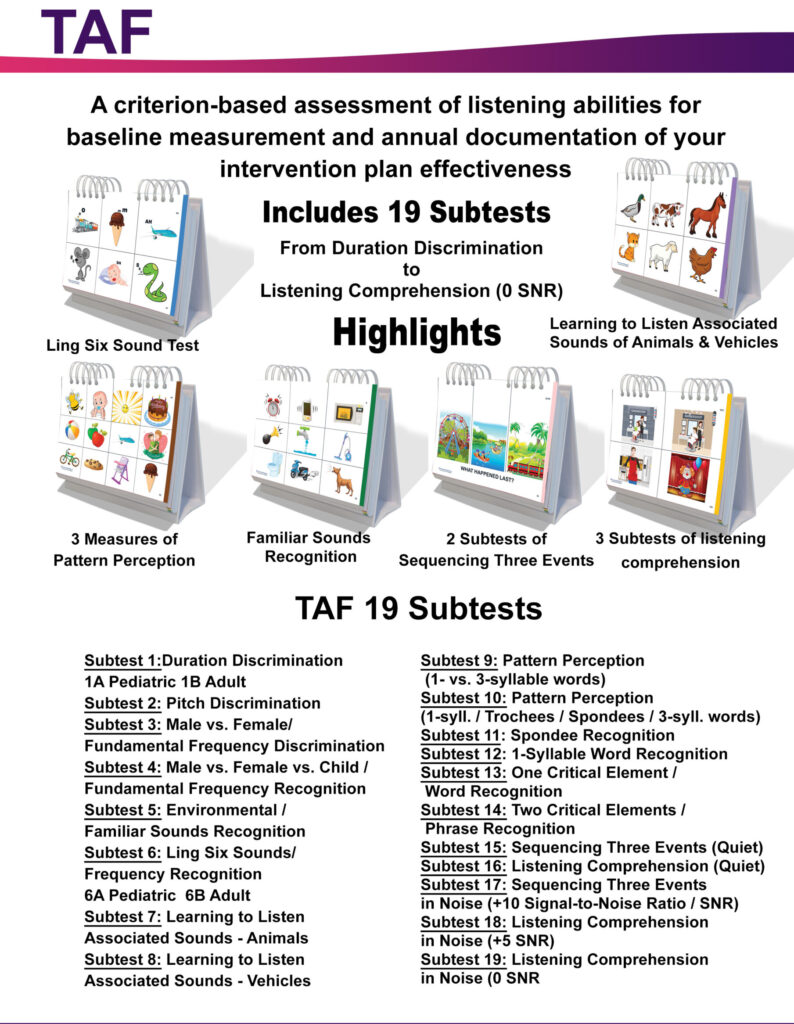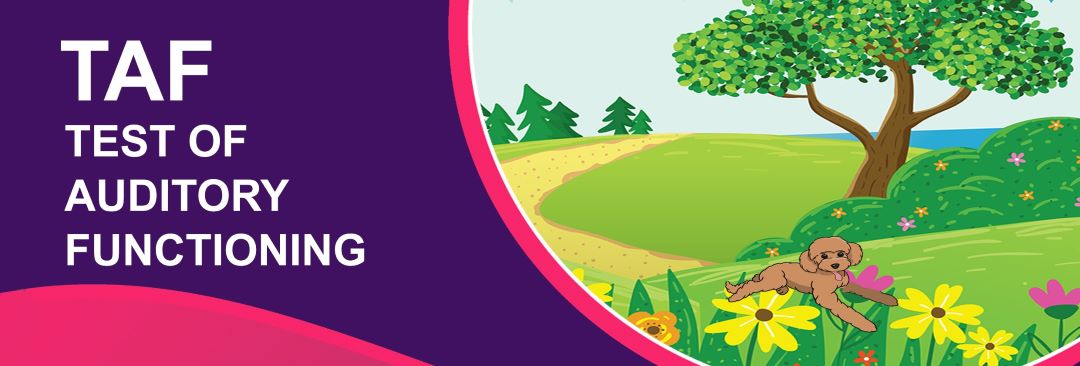Learn about the TAF, a comprehensive tool to monitor LSL development!
By Carol Flexer
Those of us in the auditory brain development business, such as Listening and Spoken Language Specialists (LSLS), educational audiologists, speech-language pathologists, members of cochlear implant teams, and teachers of the deaf, have been waiting for this test! Developed by Donald M. Goldberg, PhD, CCC-SLP/A, LSLS Cert. AVT, the Test of Auditory Functioning (TAF) is a criterion-based assessment tool for children from approximately 2 years of age through middle school.
The TAF is designed to be administered annually to children who are deaf or hard of hearing to identify their current level of auditory functioning and catalog their yearly progress.
The TAF is a criterion-based test, which measures performance against a fixed set of standards. The TAF looks at an individual child’s auditory functioning/skill attainment from one year to the next. The child’s auditory skills are not compared to other children, like in a norm-referenced test. Rather, the child’s auditory skills are compared only to the child him/herself over the years. This is a great way to chart the child’s specific progress and provides lots of insight into their language development over time.
“The need for the TAF stems from using a variety of assessments, and not having one single test able to do what the TAF does,” said Dr. Goldberg. “I designed and put together hierarchical auditory assessment subtests, fun pictures, and included tests of increasing noise difficulty to create one usable tool that covers a wide range of auditory behaviors.”
The TAF includes 19 subtests, ranging from suprasegmental discrimination through sequencing and listening comprehension tasks with competing noise/messages, and is based, in part, on the auditory hierarchy and landmark work of Norman Erber.
What I Like About the TAF
I love the whole test, but here are some specific features that stand out:
- The TAF was field-tested on over 125 children who are deaf or hard of hearing in the United States, Israel, England, and Australia. This extensive field testing showed the test’s appropriateness for toddlers through early adolescence.
- Even though the target population is children, many of the subtests are also appropriate for adults.
- The TAF comes with a 172-page easel and a small USB drive with all required audio clips, calibration tone, score sheets, a manual, and detailed administration instructions.
- The manual is excellent and includes guidance on selecting the appropriate subtest to begin administration of the TAF and ceiling recommendations.
- There is a complete script for each test item.
- The 19 subtests have an excellent progression, beginning with suprasegmentals and continuing through sequencing and then listening comprehension (using original stories) with competing noise/messages.
- The subtests are numbered and color-coded on the easel for ease of use.
- The illustrations on the 172-page easel are original, colorful, clever, and fun.
- The score sheets are free and downloadable.
Tips for Success
- First, check the child’s technology. We want the best possible signal/auditory information to reach the child’s brain. If the child’s technology is faulty, the TAF results will be compromised.
- Download a calibration app for your phone or iPad, or purchase an inexpensive SLM because the test material coming from your computer needs to be calibrated prior to test administration. Because the test is performed in a typical (hopefully quiet) room, it’s important to verify consistency of the calibration; 76 dBA at the position of the child’s head. The TAF USB drive has the calibration tone that you will use.
- Read the instruction manual thoroughly. It’s excellent!
- Even if you are an experienced test administrator, have at least one practice session to become comfortable with the easel, score sheets, and your presentation of the audio clips.
- The score sheet will be much easier to complete if it is downloaded using a color printer.
- Don’t confirm or deny the accuracy of the child’s response. The TAF will likely be given once a year for several years to evaluate the child’s progress, and we don’t want to unintentionally teach the correct response to an item.
I Highly Recommend This Test!
The TAF exemplifies a research-to-practice paradigm and is the culmination of Dr. Goldberg’s years of research into auditory functioning coupled with his vast clinical experience and expertise.
“There are no other tests quite like this one,” added Dr. Goldberg. “Many parents are uncertain about how to measure how their kids are doing. The TAF can document auditory growth and development for children wearing any type of hearing technology. The results give direction to clinicians and parents on the best way to work with the child moving forward. I hope the TAF will help all clinicians provide the best care for the children and families with whom they work.”
Dr. Goldberg designed the test for annual administration to children who are deaf or hard of hearing to identify their current level of auditory functioning and catalog their yearly progress. And the TAF does exactly what it is intended to do–identify the development of the child’s listening brain!
Thank you, Dr. Goldberg, for developing this much-needed Test of Auditory Functioning!
The TAF can be ordered from Blue Tree Publishing, Inc.
On March 27, join us for The Test of Auditory Functioning: An Explanation, Demonstration and Celebration with author Donald Goldberg, PhD, CCC-SLP/A, LSLS Cert. AVT.
Register to join us at 12:00 p.m. EST or 7:00 p.m. EST.
Prueba del funcionamiento auditivo (TAF): una herramienta auditiva integral para supervisar el desarrollo de LSL
Los profesionales que nos dedicamos al desarrollo del cerebro auditivo, como los Especialistas en Escucha y Lenguaje Hablado (LSLS), audiólogos educativos, logopedas, miembros de equipos de implantes cocleares y profesores de sordos, ¡estábamos esperando esta prueba! Desarrollada por Donald M. Goldberg, PhD, CCC-SLP/A, LSLS Cert. AVT, la Prueba del funcionamiento auditivo (Test of Auditory Functioning o TAF) es una herramienta de evaluación basada en criterios para niños de aproximadamente 2 años hasta la etapa de secundaria.
La TAF está diseñada para su administración anual a niños con sordera o hipoacusia con la finalidad de identificar su nivel actual de funcionamiento auditivo y clasificar su progreso anual.
La TAF es una prueba basada en criterios, que mide el desempeño en relación con un conjunto fijo de estándares. En esta prueba se examina el funcionamiento auditivo de un niño y sus logros de un año a otro. Las habilidades auditivas del niño no se comparan con las de otros niños, como en una prueba referenciada a un estándar. Por el contrario, las habilidades auditivas del niño se comparan únicamente con las del propio niño a lo largo de los años. Se trata de una excelente manera de registrar el progreso específico del niño y facilita una gran información sobre su desarrollo lingüístico a lo largo del tiempo.
«La necesidad de la TAF surge del uso de diversas evaluaciones y de la falta de una única prueba capaz de hacer lo que hace la TAF», afirma el Dr. Goldberg. «Diseñé y preparé subpruebas jerárquicas de evaluación auditiva con imágenes divertidas e incluí pruebas de dificultad creciente de ruido para crear una herramienta utilizable que cubra una amplia gama de comportamientos auditivos».
La TAF incluye 19 subpruebas, que van desde tareas de discriminación suprasegmental a tareas de secuenciación y comprensión auditiva con ruidos/mensajes competitivos, y se basa, en parte, en la jerarquía auditiva y el trabajo de referencia de Norman Erber.
Lo que me gusta de la TAF
Me encanta toda la prueba, pero hay algunas características específicas destacables:
- La TAF se sometió a prueba con más de 125 niños con sordera o hipoacusia en Estados Unidos, Israel, Inglaterra y Australia. Estas extensas pruebas de campo demostraron que la prueba era adecuada para niños pequeños hasta la adolescencia temprana.
- Si bien la población destinataria son los niños, muchas de las subpruebas también son apropiadas para los adultos.
- La TAF se suministra con un caballete de 172 páginas y una pequeña unidad USB con todos los clips de audio necesarios, el tono de calibración, hojas de puntuación, manual e instrucciones detalladas de administración.
- El manual es excelente e incluye orientaciones sobre la selección de la subprueba adecuada para iniciar la administración de la TAF, así como recomendaciones sobre límites máximos.
- Se facilita un guion completo para cada elemento de la prueba.
- Las 19 subpruebas tienen una excelente progresión, comenzando por las suprasegmentales y continuando con la secuenciación y la comprensión auditiva (utilizando relatos originales) con ruidos/mensajes competitivos.
- Las subpruebas están numeradas y codificadas por colores en el caballete para facilitar su uso.
- Las ilustraciones del caballete de 172 páginas son originales, coloridas, ingeniosas y divertidas.
- Las hojas de puntuación son gratuitas y se pueden descargar.
Consejos:
- En primer lugar, verifique la tecnología del niño. El objetivo es que llegue al cerebro del niño la mejor señal/información auditiva posible. Si la tecnología del niño es defectuosa, los resultados de la TAF se verán comprometidos.
- Descargue una aplicación de calibración para su teléfono o iPad, o adquiera un sonómetro económico, ya que el material de examen proveniente de su computadora se debe calibrar antes de la administración de la prueba. Dado que la prueba se realiza en una estancia típica (esperemos que silenciosa), es importante verificar la coherencia de la calibración; 76 dBA en la posición de la cabeza del niño. La unidad USB de la TAF contiene el tono de calibración que se utilizará.
- Lea detenidamente el manual de instrucciones. ¡Es excelente!
- Aunque sea un administrador de pruebas con experiencia, realice al menos una sesión de práctica para sentirse cómodo con el caballete, las hojas de puntuación y su presentación de los clips de audio.
- La hoja de puntuación será mucho más fácil de rellenar si se descarga con una impresora en color.
- No confirme ni niegue la exactitud de la respuesta del niño. Es posible que la TAF se administre una vez al año durante varios años para evaluar el progreso del niño y es conveniente no dar a conocer involuntariamente la respuesta correcta a un ítem.
¡Recomiendo encarecidamente esta prueba!
La TAF ejemplifica el paradigma de la investigación a la práctica y es la culminación de años de investigación del Dr. Goldberg sobre el funcionamiento auditivo, junto con su amplia experiencia y conocimientos clínicos.
«No existen otras pruebas como ésta», añade el Dr. Goldberg. «Muchos padres no saben cómo medir el desempeño de sus hijos. La TAF puede documentar el crecimiento y el desarrollo auditivos de los niños que utilizan cualquier tipo de tecnología auditiva. Los resultados orientan a los médicos y a los padres sobre la mejor manera de trabajar con el niño en un futuro. Espero que la TAF ayude a todos los clínicos a proporcionar la mejor asistencia a los niños y a las familias con los que trabajan».
El Dr. Goldberg diseñó la prueba para su administración anual a niños con sordera o hipoacusia con la finalidad de identificar su nivel actual de funcionamiento auditivo y catalogar su progreso anual. Y la TAF realiza exactamente lo que se pretende realizar: ¡identificar el desarrollo del cerebro auditivo del niño!
¡Gracias, Dr. Goldberg, por desarrollar esta prueba tan necesaria del funcionamiento auditivo!
Se puede realizar un pedido de la TAF a Blue Tree Publishing, Inc.
El 27 de marzo, acompáñenos en «The Test of Auditory Functioning: An Explanation, Demonstration and Celebration» (Prueba de funcionamiento auditivo: una explicación, demostración y celebración) con el autor Donald Goldberg, PhD, CCC-SLP/A, LSLS Cert. AVT.
Inscríbase para participar a las 12:00 p.m. EST u 7:00 p.m. EST.

